
Bix in
The Davenport High School

On January
28, 1918, Bix enrolled in the Davenport High School. The odd, middle of
the year enrollment was caused by his having contracted scarlet fever in
1911; thus, he had not completed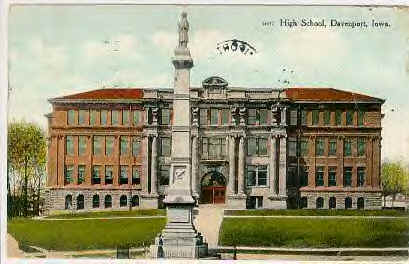 third grade during the 1911-1912 school year and was half a year behind.
Bix had enrolled in grade 8-A at Tyler School on September 3, 1917 and
had completed the grade on January 25, 1918. Bix , not counting the
absence due to illness, spent a total of eight and a half years in grammar
school. On September 2, 1918 and September 2, 1919, Bix enrolled in ninth
and tenth grades, respectively. At that time Bix was 15 and 16, respectively,
and one year behind schedule. On August 30, 1920, Bix enrolled in eleventh
grade, still one year behind. The 1920-1921 school year was the last year
Bix attended the Davenport High School. His grades were poor throughout
his high school years, and he missed school frequently. For example, in
the school year 1920-1921, Bix was absent from school 54 days. His grades
were almost equally distributed between Fair (70 to 80) and Poor (60 to
70). Needless to say that Bix did not graduate from high school at the
end of the 1921 school year. In fact, Bix had not earned enough credits
to enroll as a senior. In order to complete his high school education,
in September 1921, Bix was enrolled in Lake Forest Academy, 30 miles north
of Chicago. It turned out that Bix never finished high school: he was expelled
from Lake Forest Academy in May 1922 for unauthorized escapades.
third grade during the 1911-1912 school year and was half a year behind.
Bix had enrolled in grade 8-A at Tyler School on September 3, 1917 and
had completed the grade on January 25, 1918. Bix , not counting the
absence due to illness, spent a total of eight and a half years in grammar
school. On September 2, 1918 and September 2, 1919, Bix enrolled in ninth
and tenth grades, respectively. At that time Bix was 15 and 16, respectively,
and one year behind schedule. On August 30, 1920, Bix enrolled in eleventh
grade, still one year behind. The 1920-1921 school year was the last year
Bix attended the Davenport High School. His grades were poor throughout
his high school years, and he missed school frequently. For example, in
the school year 1920-1921, Bix was absent from school 54 days. His grades
were almost equally distributed between Fair (70 to 80) and Poor (60 to
70). Needless to say that Bix did not graduate from high school at the
end of the 1921 school year. In fact, Bix had not earned enough credits
to enroll as a senior. In order to complete his high school education,
in September 1921, Bix was enrolled in Lake Forest Academy, 30 miles north
of Chicago. It turned out that Bix never finished high school: he was expelled
from Lake Forest Academy in May 1922 for unauthorized escapades.
Bix was clearly not interested in academic work. His forte was music. Bix had been playing piano since he was three years old. He discovered jazz at the end of 1918-beginning of 1919. Bix's older brother, Charles "Burnie", bought a Victrola when he came home in December 1918 after having been in the Army since April 1917. A few records were "thrown in" with the purchase of the Victrola, among them the Original Dixieland Jazz Band recording of "Tiger Rag." Bix was completely taken by the record and borrowed a cornet from a neighbor. Acccording to Burnie, Bix taught himself how to play cornet by "slowing down "Tiger Rag" and playing it note for note with his ear in the bell." In September 1919, Bix purchased a cornet. In November 1919, Bix sat with a band playing for a school dance at the Bettenford Town Hall. Clearly, his mastery of the cornet was progressing rapidly.
In 1920,
Bix was a member of the Boy's Glee Club. Here is a photograph of the group
in 1920. Bix is in the last row, first from the right. [To see higher
resolution scan, click
here.] Bix sang baritone. On May 28, 1920, the 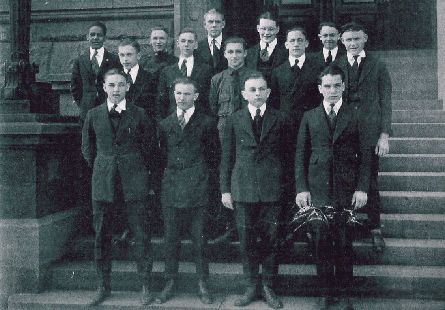 Boy's
Glee Club participated in a Concert-Vaudeville program at the Grand Opera
House. Bix was a member of the "Black Jazz Babies" and sang "Far Away In
The South." Bix also participated with another boy, Raymond Moore, in a
Jazz Specialty number, "Ma Punkin Sue."
Boy's
Glee Club participated in a Concert-Vaudeville program at the Grand Opera
House. Bix was a member of the "Black Jazz Babies" and sang "Far Away In
The South." Bix also participated with another boy, Raymond Moore, in a
Jazz Specialty number, "Ma Punkin Sue."
During the summer of 1920 and the fall of 1920, Bix played cornet with a couple of bands -Neal Buckley's Novelty orchestra and Billy Greer's Melody Jazz band. On December 21, 1920, Bix and the other members of the Buckley band auditioned for membership in Local 67, the Davenport chapter of the American Federation of Musicians. Bix, unable to sight read music, failed.
The winter
of 1920-1921 and the spring of 1921 must have been very stimulating -musically-
for Bix. Between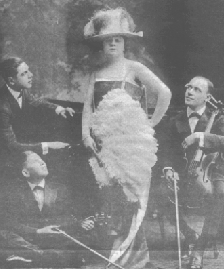 February 20 and 23, 1921, "Sophie Tucker 'At Home' With Her Five Kings
Of Syncopation" (part of the Orpheum circuit) appeared in the Columbia
Theatre. According to Bix's friend and fellow cornetist Esten Spurrier,
he and Bix went to see the show. Then, from February 27 to
March 2, 1921, "Bee Palmer and Company In "Oh Bee", a shivering sketch
by Herman Timberg, assisted by Dick Humber, Al Siegel, "Kinney," and Her
Wonderful Jazz Band" (from and ad in the Daily Times) opened at the Columbia
Theatre. According to Santo Pecora, the band consisted of Emmett Hardy
(c); Santo Pecora (tb); Leon Rappolo (cl); John Frisco (d); and Al Siegel
(p). Beatrie C. 'Bee Palmer' was a shimmy queen and her show
was too risque for a provincial town: the show closed after a few days,
and Bee,
February 20 and 23, 1921, "Sophie Tucker 'At Home' With Her Five Kings
Of Syncopation" (part of the Orpheum circuit) appeared in the Columbia
Theatre. According to Bix's friend and fellow cornetist Esten Spurrier,
he and Bix went to see the show. Then, from February 27 to
March 2, 1921, "Bee Palmer and Company In "Oh Bee", a shivering sketch
by Herman Timberg, assisted by Dick Humber, Al Siegel, "Kinney," and Her
Wonderful Jazz Band" (from and ad in the Daily Times) opened at the Columbia
Theatre. According to Santo Pecora, the band consisted of Emmett Hardy
(c); Santo Pecora (tb); Leon Rappolo (cl); John Frisco (d); and Al Siegel
(p). Beatrie C. 'Bee Palmer' was a shimmy queen and her show
was too risque for a provincial town: the show closed after a few days,
and Bee, 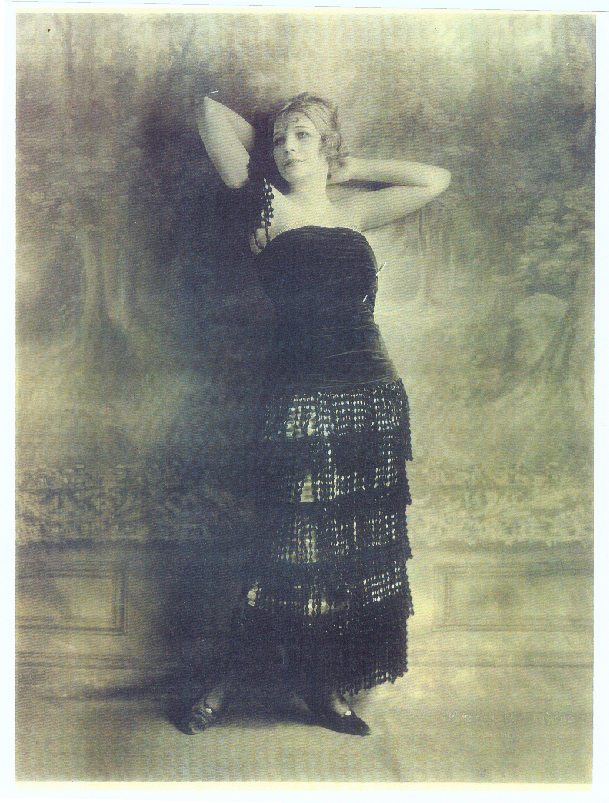 after
secretly marrying her pianist Al Siegel, left Davenport with her band.
According to Esten Spurrier, he and Bix attended every single one of the
"Oh, Bee" shows.
after
secretly marrying her pianist Al Siegel, left Davenport with her band.
According to Esten Spurrier, he and Bix attended every single one of the
"Oh, Bee" shows.
Emmett Hardy and Leon Rappolo returned to Davenport in the middle of March, joined the Carlisle Evans band at the Coliseum and stayed with the orchestra until June 1921. Bix and Esten Spurrier attended the Coliseum as often as they could. Emmett Hardy, the legendary cornetist from New Orleans is said to have had an influence on Bix. Emmett Hardy was three months younger than Bix (born June 12, 1903, in Gretan, Louisiana, across the Mississippi River from New Orleans). When he was thirteen, Emmett started playing cornet and, within a year, he was playing at house parties anddances. Thus, Hardy, although younger than Bix, was much more experienced. There is no question that Bix visited Hardy and listened to him at the Coliseum. However, we will never know how good Emmett was and how much Bix learned from him. Emmett died at age twenty-three, unrecorded. There is a myth surrounding Emmett - a myth created by his close friends among which we count Martha Boswell, Monk Hazel, and Paul Mares. Mares stated, "Emmett Hardy as far back as 1919 was playing almost the identical suff that Bix played with Goldkette and Whiteman nearly ten years later. -except that Emmett was even more sure of himself, had more ideas, and played with a push and drive that Beiderbecke never attained." Ben Pollack said, "Bix was a tin horn soloist compared with Emmett. Many of us remember the way Bix used to hang around begging to hold Hardy's horn, and asking advice. Why Emmett was so much greater there can't be a comparison." Self-convincing utterances of Hardy's friends who regret the fame of Bix versus the obscurity of Hardy? It seems to me that Mares's statement about Hardy "playing almost the identical stuff that Bix played ... ten years later" cannot be taken seriously. It is highly, unlikely, in my opinion, that Hardy could be playing in 1919 in the style that Bix played ten years later, after jazz had evolved considerably and Bix's genius for invention was completely developed. Still, I believe that Hardy exerted some influence on Bix. After all, Hardy was the first cornetist of Bix'age that Bix met and had a chance to hang around with for several months. Hardy being a professional cornetist, most probably gave Bix lots of advice and help with the technical aspects of cornet playing. I am a bit skeptic about Hardy's influence on Bix's musical and creative development. I believe that a truly superior gift for musical invention -such as Bix's- is innate and cannot be channeled by external influences: the creative stream flows out spontaneously from the internal inspiration of the inventor.
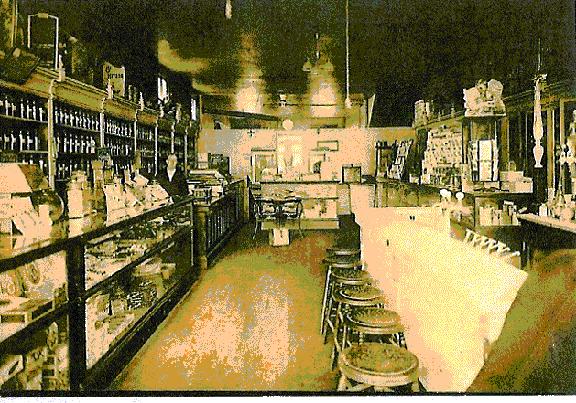 Some
time between 1918 and 1921, Bix worked in a local drugstore. Rich Johnson
writes in vol. 13, no. 2 of "Bix Notes" "Driving to our next
stop, we passed the Moetzel drugstore, now Lumpy's Tavern, on Harrison
Street. This is the drugstore where Bix once worked dispensing sodas, sundaes,
and other ice cream delights while attending Davenport High School (now
Central), just a few blocks down the street." The man standing at the counter
in the photograph on the left is Mr. Moetzel, Bix's boss. On the right,
we can see the soda fountain where Bix dispensed his sweet concoctions.
Some
time between 1918 and 1921, Bix worked in a local drugstore. Rich Johnson
writes in vol. 13, no. 2 of "Bix Notes" "Driving to our next
stop, we passed the Moetzel drugstore, now Lumpy's Tavern, on Harrison
Street. This is the drugstore where Bix once worked dispensing sodas, sundaes,
and other ice cream delights while attending Davenport High School (now
Central), just a few blocks down the street." The man standing at the counter
in the photograph on the left is Mr. Moetzel, Bix's boss. On the right,
we can see the soda fountain where Bix dispensed his sweet concoctions.
Bix completed
the junior year at Davenport High School on June 17, 1921. According to
the school year book, The Blackhawk, "To Bix Beiderbecke, a comp. at Rothmerme's
hair dressing parlor, so that the Juniors can save their money. " A story
is told that members of the Junior Class dropped coins in Bix's locker
for a haircut. Two months before school ended, Bix was arrested on alleged
charges of "lewd & lascivious act with child." The child was the five-year
old daughter of Preston Ivens who lived on Grand Avenue, about one mile
from the Beiderbecke residence. The charges were later dropped by Ivens
who said in his deposition, "Preston R. Ivens being first duly sworn on
oath says: I live at 3030 Grand Ave.
Davenport-Scott
County, Iowa. I am a student at the Palmer School. On April 22, 1921 my
little girl came home, told me that a man took her in the garage, said
some awful things to her. I ran up to the garage, then called up the police
but could get no clue. Next day I saw 2 boys whom I had seen when I went
to the garage. I asked if they saw a man take a little girl into the garage
the day before. They said yes & told me it was the Dft [defendant].
My little girl told her story to me & later to the chief of police
& the County Attorney. She said he asked her to show herself. The little
girl is 5 years old. In consideration of the childs [sic] age & the
harm that would result to her in going over with this case I would request
that no action be taken by the Grand Jury. I consulted with Dr. Eliot &
Dr. B. J. Palmer & Dr. Craven & they all besides Mr. C. H. Murphy
thought it best to drop the case for the betterment of the child."
Clearly, Bix was arrested, released on bail, and his case was sent over to the Grand Jury. The case was dismissed. Those are the facts. What are the claims? According to Mr. Ivens, his daughter told him that an unidentified man said "something awful" to her and asked her "to show herself." What is the basis for the allegation by Mr. Ivens that the man was Bix? Apparently, only the word of two unidentified boys seen by Mr. Ivens near "the garage" on the day following the alleged incident. Clearly, all the evidence brought in by Mr. Ivens was nothing but hearsay: the boys were not identified and the location of the garage was not specified. The charges were dismissed: Bix is innocent.
The nearly
three and half years -January 1918 to June 1921- that Bix spent in the
Davenport High School were crucial years for Bix. He was exposed to jazz
for the first time in December 1918-January 1919 while he was enrolled
in ninth grade. The impact that jazz had on Bix's young sensibility was
extaordinary and lasted throughout his short life. By late 1919-early 1920,
Bix was playing cornet with local groups and in high school events. By
the summer of 1920 he was playing with professional musicians. The spring
of 1921 must have had an impact on Bix's development as a jazz musican.
The legendary cornetist Emmett Hardy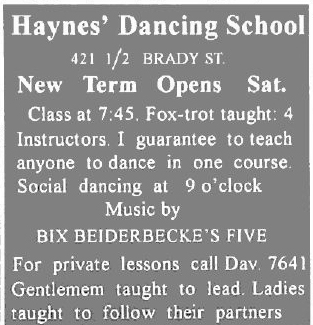 and the superb clarinetist Leon Rappolo spent about three months in Davenport
and their example as talented professional jazz musicians must have been
and added impetus for Bix to choose a career in music. By the summer of
1921, when Bix had just finished his last year in the Davenport High School,
Bix was playing professionally on several steamers and even led his own
band -The Bix Beiderbecke Five- at Haynes Dancing School. In September
of 1921, Bix left Davenport for Lake Forest Academy, and a new stage in
his too short life was about to begin.
and the superb clarinetist Leon Rappolo spent about three months in Davenport
and their example as talented professional jazz musicians must have been
and added impetus for Bix to choose a career in music. By the summer of
1921, when Bix had just finished his last year in the Davenport High School,
Bix was playing professionally on several steamers and even led his own
band -The Bix Beiderbecke Five- at Haynes Dancing School. In September
of 1921, Bix left Davenport for Lake Forest Academy, and a new stage in
his too short life was about to begin.
Letters from Davenport High School Alumni.
In response to the Davenport High School news letter, alumni wrote back with comments. Three of the letters include first-hand information from people who knew Bix personally. I present below excerpts from the letters, Links to scans of the original letters are aslo provided.
Undated, unsigned letter.
"I remember ice skating at
Vander Veer Park with Bix Beiderbecke. He could jump over several park
benches and the rest of us would stand watching and wishing we could do
it."
This is in keeping with what we know about Bix's athletic abilities. Bix was and excellent baseball and tennis player. We now can add ice skating to his skills.
Mrs. Frank Gadient, nee
Elizabeth Irwin. April 5, 1990.
To see the section about Bix
in the letter, click on this link.
(147 KB file).
We learn a couple of interesting
items from this letter.
1. Bix was playing piano in a movie theatre and provided the musical accompaniment to the silent film. This must have been sometime between 1918 and 1921.
2. Bix, while going to high school, was taking piano lessons from Professor Grade. We know that Bix took piano lessons from Professor Grade in 1911. Since Bix was a child at the time, Professor Grade came to the Beiderbecke home once a week. Bix's brother, Burnie, told the following story to Phil Evans. "Bix would persuade Professor Grade to play next week's lesson "to hear how it sounded". When the professor returned the net week, Bix would play it exactly as he had heard it. If the professor had made any mistakes the prevoius week, those mistakes were included in Bix's performance. Finally, the professor caught on to Bix's deception and informed Mother that he could no longer teach Bix the piano, and he meant it as a compliment!"
Rich Johnson did research on
Professor Grade and uncovered the following information.
Professor Charles Grade who
was born in Germany, Jan. 9, 1870 and died July 19, 1942 in Muscatine,
Iowa. Although Professor Grade lived in Muscatine, he had a studio in Davenport
at 118 1/2 W. 3rd Street in Davenport. Then, in 1925, he and Amelia Gobble
formed the Grade & Gobble Music Studies. They later moved to
228 Brady Street, room 301.
The fact that Bix was taking piano lessons in Professor Grade's studio while going to high school may not be as surprising as it seems at first glance. We know that Bix had taken lessons from Professor Grade in 1911. Bix's brother Burnie told Philip Evans that in 1914, "Mother wanted him [Bix] to have lessons again, and to learn to read music. That didn't last. Bix would "read" a piece once and then play it his way." Bix's mother repeated efforts to have Bix take piano lessons may have have been successful once again sometime between 1918 and 1921, when Bix was in high school and met Elizabeth Irwin in Professor Grade's studio. Unfortunately, we do not know how long this set of lessons lasted. However, the way Elizabeth Irwin describes the circumstances surrounding their first date (He [Bix] was studying piano under Profesor Grade and so was I. One day at the studio ..."), it would appear that Bix was taking lessons regularly.
3. Warren Postel.November
20, 1985.
To see the comments about
Bix in the letter, click on this link.
(455 KB file).
Warren Postel remember Bix's
mother telling him [Postel] that Bix took piano lessons from Professor
Ernst Otto, the musical director for the Davenport School system. Sudhalter
and Evans ("Bix: Man and Legend") tell us that Professor Otto urged Bix's
parents to bring Bix along to the summer concert programs Professor Otto
ran, but there was no mention of Bix taking piano lessons. Is it possible
that Bix, in addition to have been instructed on the piano by Professor
Grade, also took some piano lessons from Professor Otto?
Warren Postel mentions appearances
in late 1929 of Bix in Danceland and the Kappa Delta Dance at the Blackhawk
Hotel. These were known from Phil Evans research.
Additional recollections by people who knew Bix when he was in the Davenport High School were collected by Jim Arpy and are transcribed in http://ms.cc.sunysb.edu/~alhaim/peoplewhoknewbix.htm
Last, but not least, Vera Cox, Bix's high school sweetheart, is mentioned extensively in Bix's biographies. A letter from Bix to Vera is transcribed in "Bix: Man and Legend" by Richard Sudhalter and Philip Evans abd in "Bix. The Leon Bix Beiderbecke Story" by Philip and Linda Evans.
I am grateful to Rich Johnson for scans of
the letters and of the Glee Club photograph. The photo was copied and restored
by Bob McCue, the school historian, from a June 1920 issue of The Blackhawk,
which was a student newsletter. The school year book was also named The
Blackhawk.
This page was uploaded on
July 8, 2003. Corrections and additions were made on July 9, 2003.